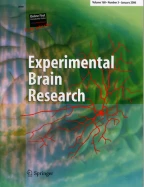Summary
Motion after-effects were elicited from striate cortical cells in lightly-anaesthetized cats, by adapting with square-wave gratings or randomly textured fields drifting steadily and continuously in preferred or null directions. The time-course and recovery of responsiveness following adaptation were assessed with moving bars, gratings or textured fields. Results were compared with controls in which the adapting stimulus was replaced by a uniform field of identical mean luminance, and also assessed in relation to the strength and time course of adaptation. Within 30–60 s adaptation, firing declined to a steady-state. Induced after-effects were direction-specific, and manifest as a transitory depression in response to the direction of prior adaptation, recovering to control levels in 30–60 s. Maximal after effects were induced by gratings of optimal drift velocity and spatial frequency. With rare exceptions after-effects were restricted to driven activity; no consistent effects on resting discharge were observed. The onset of adaptation, and the recovery period, were more rapid in simple cells, although after effects of comparable strength were elicited from simple and from standard complex cells. Special complex cells, including many of the more profoundly texture-sensitive neurones in the cortex, were more resistant to adaptation. The results support the conclusion that psychophysically measured adaptation and induced motion after-effect phenomena reflect the known properties of cortical neurones.
Similar content being viewed by others
References
Albrecht DG, Farrar SB, Hamilton DB (1984) Spatial contrast adaptation characteristics of neurones recorded in the cat’s visual cortex. J Physiol (Lond) 347: 713–739
Barlow HB, Hill RM (1963) Evidence for a physiological explanation of the waterfall phenomenon and figural after-effects. Nature 200: 1345–1347
Cleland BG, Levick WR (1974) Brisk and sluggish concentrically organized ganglion cells in the cat’s retina. J Physiol (Lond) 240: 421–456
Cleland BG, Levick WR (1975) The nature of the ‘induced’ discharge of cat retinal ganglion cells. J Physiol (Lond) 244: 60–61P
Dealy RS, Tolhurst DJ (1974) Is spatial adaptation an after-effect of prolonged inhibition? J Physiol (Lond) 241: 261–270
Hammond P (1978a) On the use of nitrous oxide/oxygen mixtures for anaesthesia in cats. J Physiol (Lond) 275: 64P
Hammond P (1978b) Inadequacy of nitrous oxide/oxygen mixtures for maintaining anaesthesia in cats: satisfactory alternatives. Pain 5: 143–151
Hammond P (1980) A semi-chronic preparation for cortical recording. J Physiol (Lond) 298: 3–4P
Hammond P, Ahmed B (1985) Length summation of complex cells in cat striate cortex: a reappraisal of the “special” “standard” classification. Neuroscience 15: 639–649
Hammond P, MacKay DM (1975) Differential responses of cat visual cortical cells to textured stimuli. Exp Brain Res 22: 427–430
Hammond P, MacKay DM (1981) Modulatory influences of moving textured backgrounds on responsiveness of simple cells in feline striate cortex. J Physiol (Lond) 319: 431–442
Hammond P, Mouat GSV (1986a) A versatile generator of static visual noise, interfaced with the Innisfree “Picasso” image synthesizer. J Physiol (Lond) 381: 3P
Hammond P, Mouat GSV (1986b) Interocular transfer of motion after-effects in complex cells of feline striate cortex. J Physiol (Lond) 381: 99P
Hammond P, Mouat GSV (1988) Neural correlates of motion after-effects in cat striate cortical neurones: interocular transfer. Exp Brain Res 72: 21–28
Hammond P, Smith AT (1982) On the sensitivity of complex cells in feline striate cortex to relative motion. Exp Brain Res 47: 457–460
Hammond P, Smith AT (1983) Directional tuning interactions between moving oriented and textured stimuli in complex cells of feline striate cortex. J Physiol (Lond) 342: 35–49
Hammond P, Smith AT (1984) Sensitivity of complex cells in cat striate cortex to relative motion. Brain Res 301: 287–298
Hammond P, Mouat GSV, Smith AT (1985) Motion after-effects in cat striate cortex elicited by moving gratings. Exp Brain Res 60: 411–416
Hammond P, Ahmed B, Smith AT (1986) Relative motion sensitivity in cat striate cortex as a function of stimulus direction. Brain Res 386: 93–104
Hammond P, Mouat GSV, Smith AT (1986) Motion after-effects in cat striate cortex elicited by moving texture. Vision Res 26: 1055–1060
Kirtenbach W, Magnussen S (1981) Inhibition, disinhibition, and summation among orientation detectors in human vision. Exp Brain Res 43: 193–198
Maffei L, Fiorentini A, Bisti S (1973) Neural correlate of perceptual adaptation to gratings. Science 182: 1036–1038
Movshon JA, Lennie P (1979) Pattern-selective adaptation in visual cortical neurones. Nature 278: 850–852
Nakayama K (1985) Biological image motion processing: a review. Vision Res 25: 625–660
Saito H-A, Fukada Y (1973) Repetitive firing of the cat’s retinal ganglion cell. Vision Res 13: 263–270
Sekuler R, Pantle A, Levinson E (1978) Physiological basis of motion perception. In: Held R (ed) Handbook of sensory physiology, Vol VIII. Perception. Springer, Berlin Heidelberg New York
Smith AT (1985) Velocity coding: evidence from perceived velocity shifts. Vision Res 25: 1969–1976
Smith AT, Hammond P (1985) The pattern specificity of velocity after-effects. Exp Brain Res 60: 71–78
Smith AT, Musselwhite MJ, Hammond P (1984) The influence of background motion on the motion after-effect. Vision Res 24: 1075–1082
Thompson P (1981) Velocity after-effects: the effects of adaptation to moving stimuli on the perception of subsequently seen moving stimuli. Vision Res 21: 337–345
Vautin RG, Berkley MA (1977) Responses of single cells in cat visual cortex to prolonged stimulus movement: neural correlates of visual after-effects. J Neurophysiol 40: 1051–1065
von der Heydt R, Hanny P, Adorjani C (1978) Movement after-effects in the visual cortex. Arch Ital Biol 116: 248–254
Author information
Authors and Affiliations
Rights and permissions
About this article
Cite this article
Hammond, P., Mouat, G.S.V. & Smith, A.T. Neural correlates of motion after-effects in cat striate cortical neurones: monocular adaptation. Exp Brain Res 72, 1–20 (1988). https://doi.org/10.1007/BF00248495
Received:
Accepted:
Issue Date:
DOI: https://doi.org/10.1007/BF00248495
